Big 5, Little 5, Shy 5, Impossible 5 (and more!) – this is the ULTIMATE list of 50+ African Safari Animals to see in the wild – including. facts, pics, and where to find them!
If you love animals – and seeing animals in their natural habitat – Africa is undoubtedly one of the best places to go. Home to over 1,100 different species of mammals and over 2,600 species of birds, just seeing 1/10th of these African animals would make for an amazing Safari experience.
But not everyone can go on safari – and not everyone who goes on safari gets to see all the animals (because that’s the beauty of them being wild..) and so we’ve put together this ultimate guide to what are the most well known of the African Safari animals, starting with the Big 5, running through the other common 5’s heard in Safari speak (more on them below!) and finally listing 25+ other incredible animals and birds that it’s possible to see on the continent.
For each we’ve included a photo, their current population numbers, conservation status, where you can find them and some fun facts for both your general knowledge and/or whatever virtual quiz you’re running at the moment! (Click here if you want to try and solve some animal anagrams!)
It’s also a great resource for children to learn all about African animals – even if we do say so ourselves! – and was another way I could use some of my thousands of photos from my latest African safari(!)
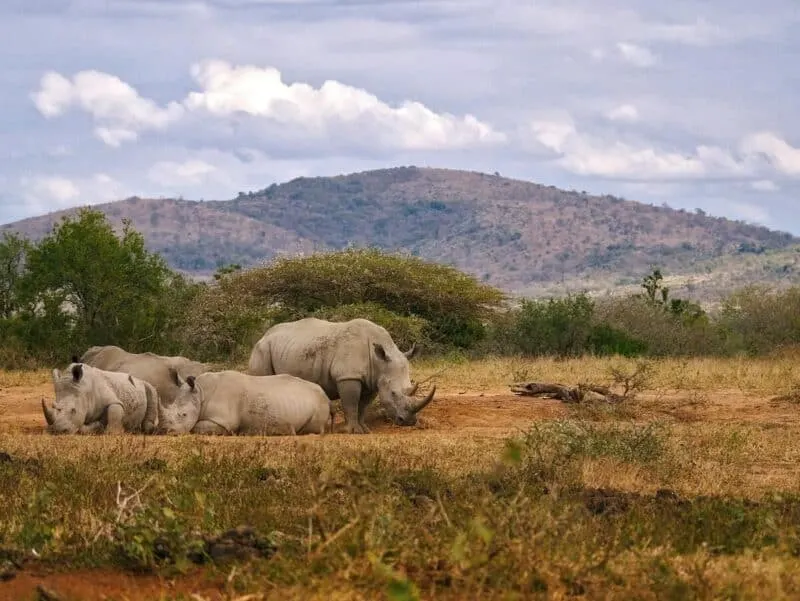
Disclaimer: Almost all posts on this site contain Affiliate links, and this one about African Safari Animals: Big 5, Little 5 African Animals, Shy 5 African Animals, Impossible 5 African Safari Animals & Ugly 5 African Safari Animals is no different. This means that if you click on any of the links in this post (and make a purchase) I may receive a small commission at absolutely no cost to you. Each post is carefully crafted to (hopefully!) answer all your questions and recommendations are made where we believe they will improve your trip and help with your planning. As such we thank you in advance should you decide to click & buy. Read my full Disclosure here.
In This Post
African Safari Animals: The Big 5, Little 5, Ugly 5 & More!
Who are the Big 5 Animals?
Africa’s Big 5 Animals are Lions, Leopards, Elephants, Rhinoceroses (black and white) and African Buffalo (also known as the Cape Buffalo). Often revered as the ‘must-see’ animals on any African Safari, the name Big 5 actually has more sinister origins. The big five was originally a term used by hunters to describe the African animals that were considered as the hardest to hunt on foot. Slightly less glamorous, huh?!
But these five animals are some of the most beautiful and majestic animals on the planet, the most sought after wildlife of Africa and are a take-your-breath-away kinda sight to see in the wild. Scroll down to find out some fun facts about each animal, their numbers in the wild, and in which African countries you can find them.
Lion
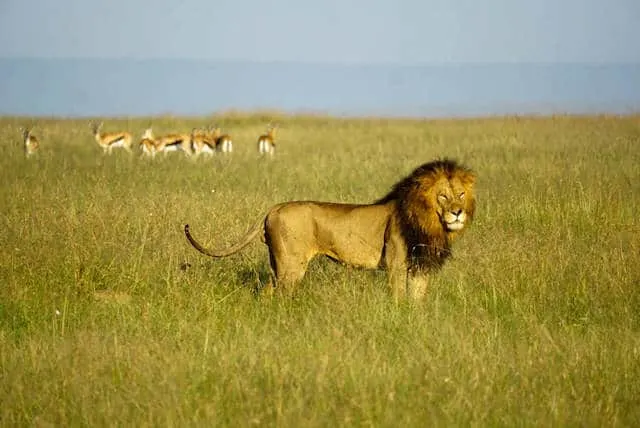
Scientific Name: Panthera Leo
Lions Left in the Wild: approx. 20,000 (in 2020)
Lifespan: 10 to 18 in the wild (30 in captivity)
Conservation Status: Vulnerable (East Africa) & Critically Endangered (West Africa)
Countries with the highest populations: Tanzania, Kenya, South Africa, Botswana, Zambia and Zimbabwe
Collective Noun: Pride of Lions
Best Game Parks to see Lions:
Masai Mara National Reserve (Kenya); Samburu National Reserve (Kenya); Meru National Park (Kenya); Serengeti National Park (Tanzania); Okavango Delta (Botswana); Kruger (South Africa), Ngorongoro Crater (Tanzania) & Murchison Falls National Park, known locally as Kabalega National Park (Uganda)
Quick Facts about African Lions:
- Lions are extinct in 26 African countries.
- The species is threatened by the illegal bushmeat trade, habitat loss, unsustainable trophy hunting, and conflict with local people due to the real or perceived threat lions pose to livestock.
- Samuel Johnson’s Dictionary of the English Language (1755) described them as “the fiercest and most magnanimous of the four-footed beasts.”
- Lions are the most social of the feline species, living in prides of up to 25 individuals.
- It is the lionesses that hunt the prey, usually between dusk and dawn, but the males eat first, and the cubs get what’s left after the adults have fed.
- Where food is plentiful, lions will gorge themselves into a food coma, with males consuming as much as 15% of their body weight.
- Typically, the older the male lion, the darker his mane.
- Lion cubs are born with blue eyes that change to amber or brown when around the age of two to three months.
- There is no set breeding season for lions but when the time is right, lions will mate roughly every thirty minutes (each mating lasting for around 20 seconds) for three days (nonstop!) to create litters of 1-4 cubs born after 110 days gestation.
- A lion’s roar is the loudest of all the cats, and can be heard up to 8km away.
.
Leopard

Scientific Name: Panthera pardus
Leopards Left in the Wild: unknown (in 2020)
Lifespan: 10 to 14 in the wild (23 in captivity)
Conservation Status: Vulnerable
Countries where they can be found: Multiple countries in Sub-Saharan Africa including Tanzania, Kenya, South Africa, Botswana, Zambia and Zimbabwe
Collective Noun: Leap of Leopards
Best Game Parks to see Leopards:
Maasai Mara National Reserve (Kenya); Serengeti National Park (Tanzania); Okavango Delta (Botswana); South Luangwa National Park (Zambia); & Kruger National Park (South Africa)
Quick Facts about African Leopards:
- Leopards are native in more than 35 African countries.
- There are 9 recognized sub-species.
- The species is threatened by illegal killing for their skins and other body parts used for ceremonial regalia, conflict with local people, rampant bushmeat poaching, and poorly managed trophy hunting.
- Leopards have adapted retinas meaning they can see seven times better in the dark than humans.
- Leopards can run up to 58km/h, and are also famous for their incredible agility and strength to climb trees while dragging a kill that is sometimes heavier than their body weight.
- African leopards mate all year round and have a gestation period of 2.5 months.
- Female leopards protect their young cubs by hiding them in lairs.
– What to Pack for an African Safari Guide (which includes recommended safari clothing and what NOT to Bring)
– 30 Amazing African Adventures for your Africa Bucket List
– The 25 BEST Places to Visit in Africa (with photos & things to do!)
– Make the Most of Your Time in Kenya’s capital with our Top 25+ Things to do in Nairobi
– Take a Virtual Safari in the Masai Mara National Reserve or Etosha National Park
– 30 Movies About Africa to Inspire You to Visit the Continent
.
Cape Buffalo
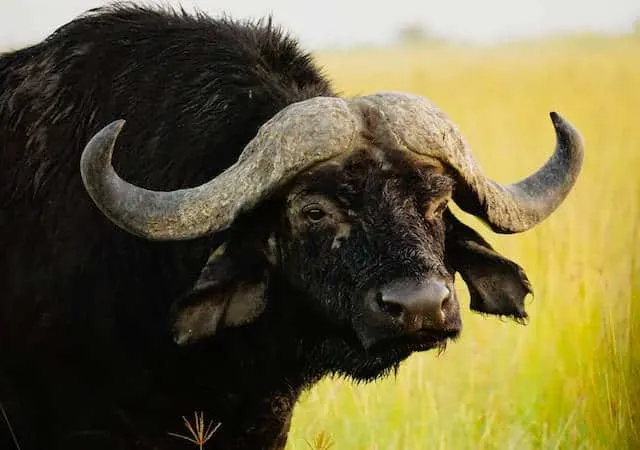
Scientific Name: Syncerus caffer
Buffalo Left in the Wild: 400,000 (in 2020)
Lifespan: Ranges from 11-22 years
Conservation Status: Near Threatened
Countries where they can be found: Countries of Southern and East Africa
Collective Noun: Herd of Buffalo
Best Game Reserves to see Cape Buffalo:
Masai Mara National Park in Kenya; Serengeti National Park (Tanzania); Chobe National Park (Botswana); Lower Zambezi National Park (Zambia); Hwange National Park (Zimbabwe) & Kruger (South Africa)
Quick Facts about Cape Buffalo:
- Cape Buffalo are just one of the four distinct species of African Buffalo.
- The males can weigh twice as much as the females.
- Herds can contain thousands of animals in one herd.
- They form part of the bovine sub-family.
- Cape Buffalo are herbivores and similar to cows, they chew cud to extract necessary nutrients.
- They are aggressive and considered a dangerous animal
.
Rhino (Black & White)
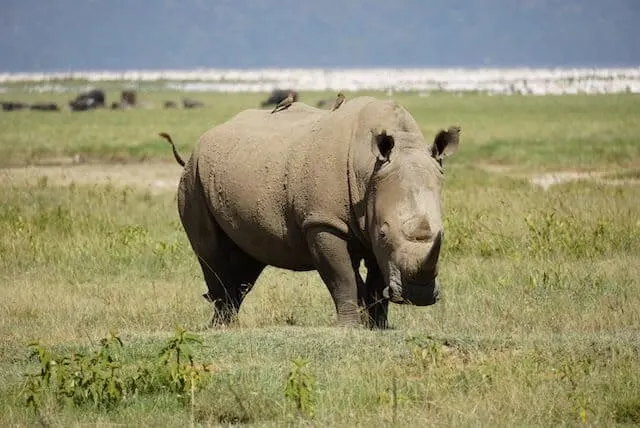
Scientific Name: Rhinocerotidae (Diceros bicornis- Black Rhino or Ceratotherium simum – White Rhino)
Rhinos Left in the Wild: 6,487 Black Rhino and 10,080 White Rhino
Lifespan: 35 to 40 years
Conservation Status: Critically Endangered (Black Rhino) & Near Threatened (White Rhino)
Countries where they can be found: Countries in Sub-Saharan Africa including Angola, Namibia, Tanzania, Kenya and Mozambique. Black Rhinos have also been reintroduced into South Africa, Zambia and Rwanda.
Collective Noun: Crash of Rhinoceros
Best Game Parks to see Rhinos:
Etosha National Park (Namibia); Ziwa Rhino Sanctuary (Uganda); Nairobi National Park (Kenya); Lake Nakuru National Park (Kenya); Ol Pejeta Conservancy (Kenya); Serengeti National Park (Tanzania); & Kruger (South Africa).
Quick Facts about African Rhinos:
- There are two species of African Rhino- the White Rhino and the Black Rhino
- The word Rhinoceros literally means ‘nose horn’ in Greek.
- White Rhinos are the second-largest land mammal.
- The name White Rhino actually comes from the Afrikaans word ‘weit’ which really means wide (referring to the width of it’s mouth).
- Although both grey in colour, you can tell the difference between the black and white rhino from the shape of their jaw. A white rhino has a wide mouth and the black rhino has a narrow, more pointed jaw.
- The species is threatened by illegal trading of the Rhino horn, poaching and hunting and habitat loss.
.
African Elephant
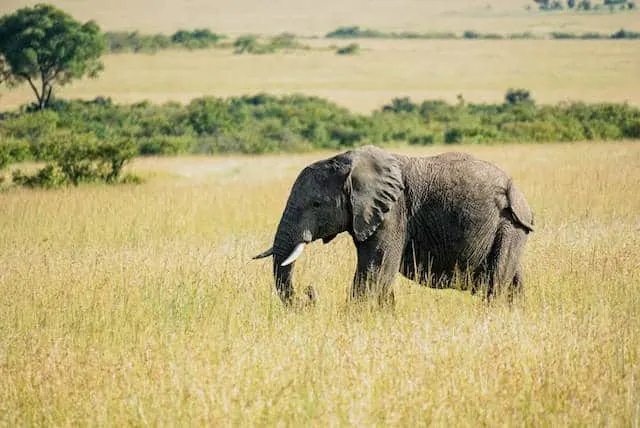
Scientific Name: Loxodonta africana
Elephants Left in the Wild: 415,000
Lifespan: 60 to 70 years
Conservation Status: Vulnerable
Countries where they can be found: African Elephants can be found in 37 countries throughout Africa. They reside in most regions except for Northern Africa.
Collective Noun: Herd of Elephants
Best Game Parks to see Elephants:
Chobe National Park (Botswana); Amboseli National Park (Kenya), Masai Mara in Kenya, Tsavo National Parks (Kenya); Okavango Delta (Botswana); Kruger National Park (South Africa); Hwange National Park (Zimbabwe) & Etosha National Park (Namibia)
Quick Facts about the African Elephant:
- Elephants are the world’s largest land mammal and a popular animal on safari.
- Cows carry the calf for 22 months before giving birth.
- A mother cow will give birth to only one calf every three to six years.
- The species is threatened by ivory poachers who hunt the animals for their tusks.
- Elephants herd in groups led by the ‘matriarch’ female. Male elephants tend to roam alone or in smaller all-male groups.
.
Who are the Little 5 African Safari Animals?
The “Little 5 or Small 5” of Africa are the Elephant Shrew, Ant Lion, Rhinoceros Beetle, Buffalo Weaver and Leopard Tortoise. And are so-called because after safari operators in Southern Africa started using the ‘Big 5’ as the must-see animals – with great marketing success, conservationists called for visitors to acknowledge the smaller and lesser-noticed animals.
In an attempt to be the Big 5’s equal and create a link between the two, the name of the 5 small animals mimic those of the Big Five (Elephant = Elephant Shrew, Buffalo = Buffalo Weaver etc)
Elephant Shrew
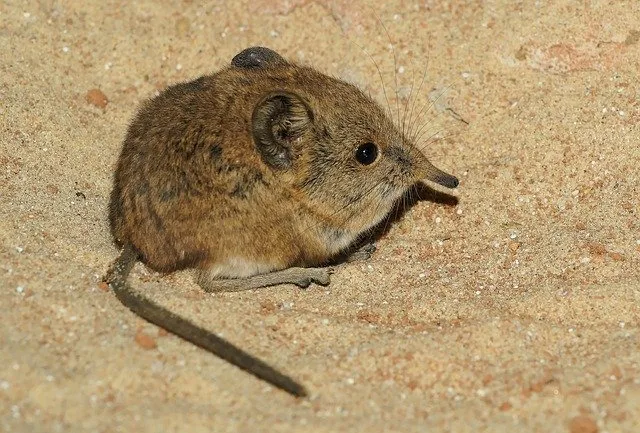
Scientific Name: Rhynchocyon cirnei (depending on the species)
Elephant Shrews Left in the Wild: Unknown
Lifespan: 2 to 4 years
Conservation Status: Least Concern
Countries where they can be found: Elephant Shrew are widespread throughout Africa, but the Rhynchocyon cirnei species can be found in the Democratic Republic of Congo, Malawi, Tanzania, Zambia and Mozambique.
Quick Facts about the Elephant Shrew:
- There are around 19 different species, all residing in Africa.
- Females can give birth three to five times per year and gestation is only 45-60 days.
- They have exceptionally long hind legs allowing them to jump as high as three feet in the air.
- While they are widespread, no species is particularly common. They are also very timid- meaning sightings are quite rare.
- Females carry food in small inner-cheek pouches.
Ant Lion
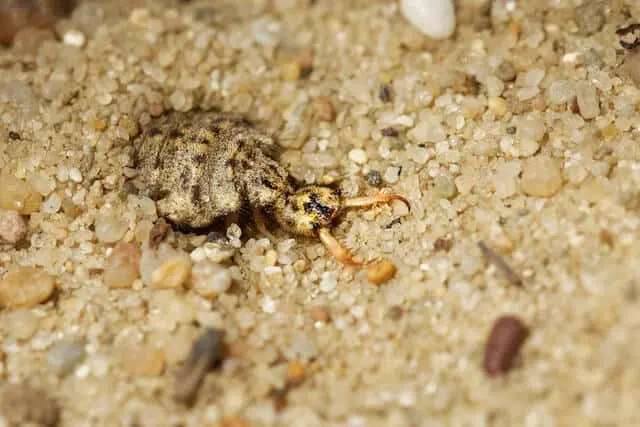
Scientific Name: Myrmeleontidae
Antlions Left in the Wild: Unknown
Lifespan: 25 to 45 days
Conservation Status: Not protected
Countries where they can be found: Different species of Antlion can be found all over the world but mostly they reside in hot countries and dry habitats.
Quick Facts about the Antlion:
- There are around 2,000 species of Antlion in total
- It is called the Antlion because it catches its prey of ants and other small insects.
- Its predatory mechanism is a a small crater in the sand or ground, dug using its abdomen. These can be as large as 2 inches deep and 3 inches wide.
- Its ‘pounce’ is said to have been observed by early scholars who then gave it the ‘lion’-like comparison.
.
Rhinoceros Beetle
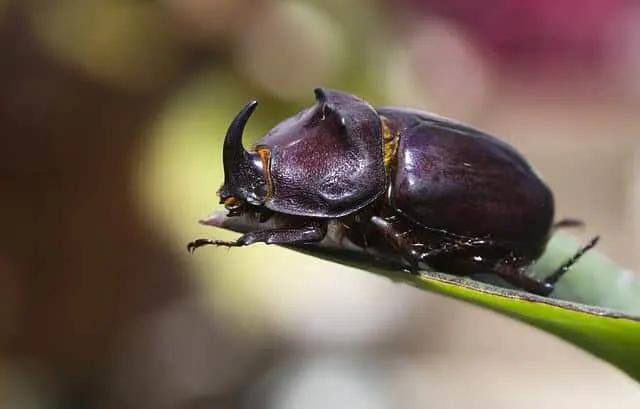
Scientific Name: Dynastinae
Rhinoceros Beetles Left in the Wild: Unknown (300 species)
Lifespan: 3-6 months (depending on the species)
Conservation Status: Not protected
Countries where they can be found: Different species of Rhinoceros Beetle are said to be found on every continent except Antarctica.
Quick Facts about the Rhinoceros Beetle:
- The Rhinoceros Beetle is thus named because of the horned features on the frontal portion of the male insects.
- There are over 300 species of Rhinoceros Beetle.
- They can sometimes be called the Atlas Beetle or the Hercules Beetle.
- Some species can lift up to 850 times their own body weight.
Buffalo Weaver

Scientific Name: Bubalornithinae
Buffalo Weaver Left in the Wild: Unknown
Lifespan: Up to 20 years (depending on the species)
Conservation Status: Least Concern
Countries where they can be found: Buffalo Weaver are native to a number of North and East African countries including Ethiopia, Kenya, Somalia, Sudan, Tanzania, and Uganda.
Quick Facts about the Buffalo Weaver:
- There are three species of Buffalo Weaver in Africa: the Red-billed buffalo weaver, White-billed buffalo weaver and the White-headed buffalo weaver.
- Sometimes known as the ‘Architect of the bird world’, they make elaborate nests with partitioned interiors and thorny outer casing to deter predators.
- The Buffalo weaver often follows hers of livestock or reside in urbanized habitats.
.
Leopard Tortoise
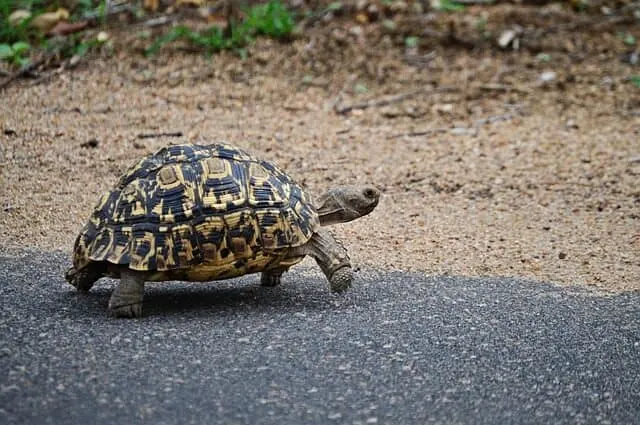
Scientific Name: Stigmochelys pardalis
Leopard Tortoise Left in the Wild: Unknown
Lifespan: Up to 75 years (approx.)
Conservation Status: Least Concern
Countries where they can be found: Leopard Tortoise are native to a large number of African countries including: Angola, Botswana, Eswatini, Ethiopia, Kenya and South Africa.
Quick Facts about the Leopard Tortoise:
- The Leopard Tortoise resides in semi-arid shrubland of the Sahara.
- Their name comes from the distinct markings on their shell.
- The Leopard Tortoise is widespread across Africa, inhabiting countries from Sudan all the way south to the Cape.
- The Leopard Tortoise is the only member of the tortoise family that can swim.
.
The Ugly 5 African Animals
The Ugly 5 African Animals are the Hyena, Wildebeest, Vulture, Warthog, and the Marabou Stork.
With the success of the Big 5 and the Little 5, the Ugly 5, considered Africa’s ugliest animals, became a collective. (Although I think some have been unfairly judged as some of them are quite cute – I mean look at that cutie hyena below…)
Hyena
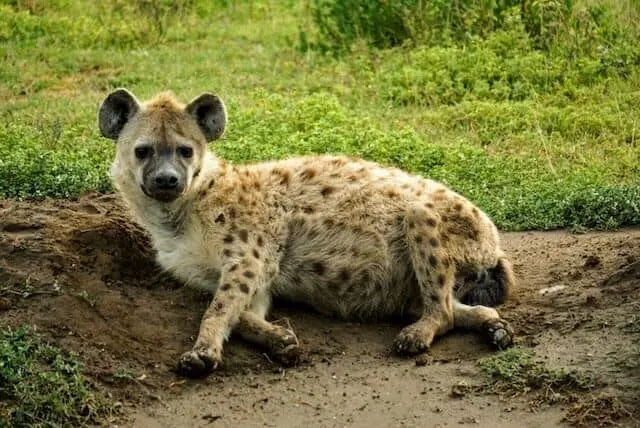
Scientific Name: Crocuta Crocuta (depending on sub-species)
Hyena Left in the Wild: Unknown
Lifespan: Up to 25 years (approx.)
Conservation Status: Least Concern
Countries where they can be found: Hyena are widespread across western, eastern, central and southern Africa.
Collective Noun: Cackle of Hyenas
Quick Facts about the Hyena:
- There are three subspecies of Hyena: the spotted Hyena, Brown Hyena and Striped Hyena.
- They tend to roam in clans of up to 80 individuals.
- Snares kill up to 400 adult hyenas per year, meaning humans are their number one threat.
- The clans of the spotted hyena species are matriarchal, with females often larger and more muscular than their male counterparts due to testosterone levels.
.
Wildebeest
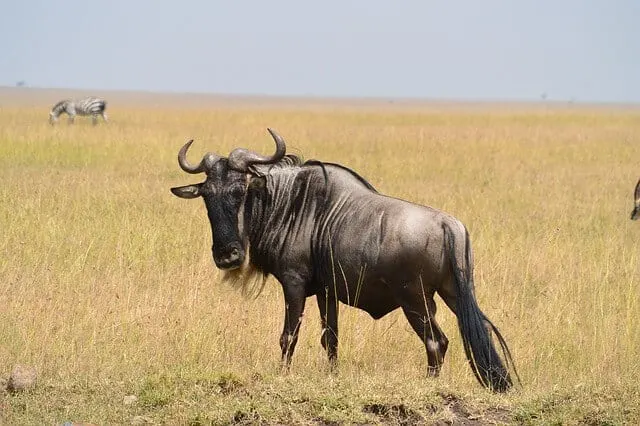
Scientific Name: Connochaetes Taurinus
Wildebeest Left in the Wild: Unknown (but lots)
Lifespan: 20 years
Conservation Status: Least Concern
Countries where they can be found: Angola, Botswana, Eswatini, Mozambique, Namibia, South Africa, Tanzania, Zambia and Zimbabwe
Collective Noun: Implausibility of Wildebeest
Quick Facts about Wildebeest:
- The foreboding appearance of the Wildebeest earned it its name meaning ‘Wild Beast’ in Afrikaans.
- The common Blue Wildebeest is a member of the Antelope family.
- It’s major predators are among the most menacing of African wildlife: Lions, Cheetahs, Hyenas and Wild Dogs.
- They migrate north en masse between May and June in search of more lush pastures. This incredible operation can see up to 1.5 million Wildebeest making the annual pilgrimage and as such the Wildebeest Migration is one of Africas top wildlife experiences.
.
Vulture
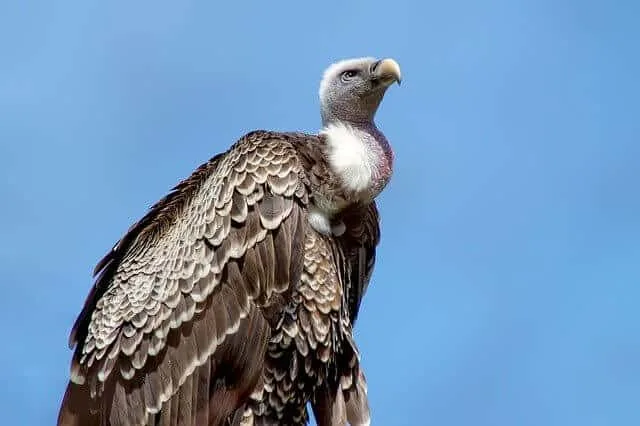
Scientific Name: Various depending on sub-species
Vultures Left in the Wild: There are 11 different species of vulture in Africa. Some are common, many are protected species. Numbers are as low as 1,300 depending on the species.
Lifespan: 10-30 years
Conservation Status: Ranging from Critically Endangered to Least Concern.
Countries where they can be found: Different species of Vulture can be found across several countries throughout Africa.
Collective Noun: Committee, Venue or Volt of Vultures
Quick Facts about Vultures:
- At least one species of vulture can be found on every continent except for Australia and Antarctica.
- There are 11 species of vulture in Africa, seven of which are endangered or critically endangered species.
- West Africa has lost 90% of the native White-backed vulture.
- Humans are the Vulture’s biggest threat. Their decreasing numbers are a result of habitat damage and poisoning.
- Vultures have a key role to play in nature and are well respected for their ability to keep wildlife reserves nice and “clean”
.
Warthog
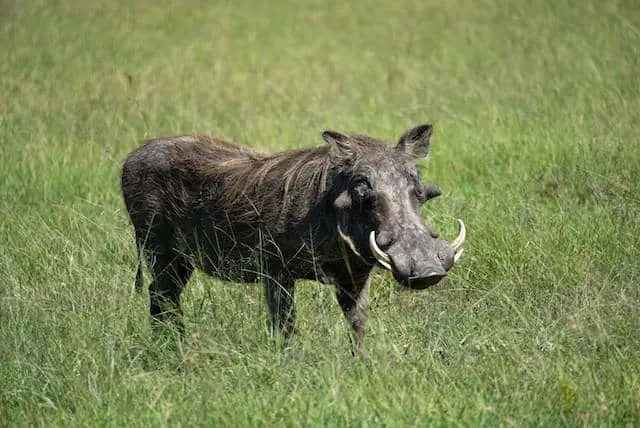
Warthog in the Masai Mara in Kenya
Scientific Name: Phacochoerus africanus (Common Warthog) or Phacochoerus aethiopicus (Desert Warthog)
Warthogs Left in the Wild: 250,000 (approx.)
Lifespan: 15-18 years
Conservation Status: Least Concern.
Countries where they can be found: Warthogs are native to a number of countries across western, eastern, central and southern Africa including Mauritania, Nigeria, Ethiopia, Tanzania and South Africa.
Collective Noun: Sounder of Warthogs
Quick Facts about Warthogs:
- The common warthog is a wild member of the pig family found in grassland, savanna, and woodland in sub-Saharan Africa.
- Warthogs are plump, hooved animals with large nostrils at the end of the snout; they have little fur, except for a mane that goes down the spine to the middle of the back.
- Thrown into the spotlight with the release of the Lion King back in 1994, when you are on Safari most guides will refer to them as Pumba.
- Pumba means silly or foolish in Swahili – and are so-called because they display those characteristics in the wild. For example, when running away from a predator warthogs will suddenly stop – as they have forgotten why they were running.
- And when they running, they point their hair tufted tails to the sky so fellow Warthogs can follow them – which is effectively an aerial with a pom-pom raised high off their backs for all predators to see. (Also, watching them run is actually quite entertaining).
- Their upper tusks are enlarged canine teeth that protrude upwards from the mouth and can grow to 25cm. They use them for digging, fighting with rivals and defending themselves against predators.
- They eat by lowering their bodies to the ground by resting on the bent forearms.
- Their predators include lions, leopards, cheetahs, hyenas, wild dogs, crocodiles, and even some species of vultures.
The Marabou Stork
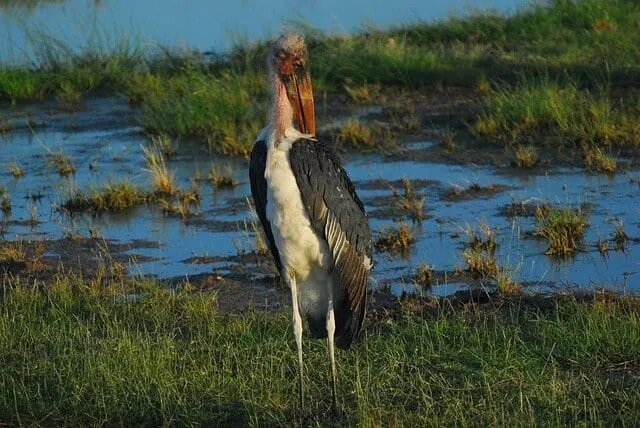
Scientific Name: Leptoptilos crumenifer
Lifespan: 25 years
Conservation Status: Least Concern.
Countries where they can be found: Marabou Storks are widespread throughout western, eastern, central and southern African countries.
Collective Noun: An Undertaker’s Convention of Marabou Stork
Quick Facts about The Marabou Stork:
- While storks generally conjure an image of a beautiful, slender white bird, the Marabou Stork is widely known as ‘the world’s ugliest bird’. It can also be known as the ‘Undertaker bird’ on account of its black cloak-like features.
- Adult Marabou can reach up to 152 cm tall, and its wingspan can stretch up to 2.2 – 2.9 m.
- Another interesting fact, perhaps not helping with their bad rep, the Marabou Stork is said to defecate on its own feet and legs. This process helps them to regulate their body temperature.
.
The Shy 5 African Animals
The Shy 5 of Africa are the Meerkat, Aardvark, Porcupine, Aardwolf and the Bat Eared Fox.
Yet another list, primarily for marketing purposes, the Shy 5 are referred to as such because they are typically hard to spot.
Meerkat
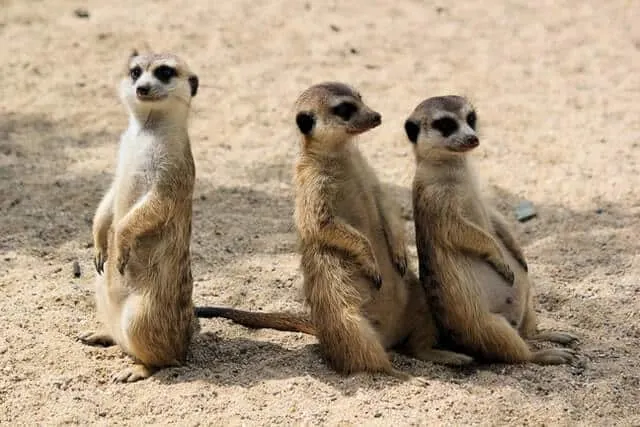
Scientific Name: Suricata suricatta
Lifespan: 12 years (approx.)
Conservation Status: Least Concern.
Countries where they can be found: Meerkats are found in the southern African countries of Namibia, Botswana and South Africa and a small number can be found in Angola.
Collective Noun: Mob or Gang of Meerkats
Quick Facts about Meerkat:
- Members of the mongoose family, Meerkats are social, team-spirited animals who live in mobs of up to 50 individuals. They work together to build burrows, protect each other against predators and find food.
- Meerkats have exceptional eyesight and can spot predators up to 300m away.
- They are omnivorous and eat small reptiles as well as eggs, insects, fruit and foliage.
.
Aardvark

Scientific Name: Orycteropus afer
Lifespan: Up to 23 years
Conservation Status: Least Concern.
Countries where they can be found: Aardvarks are widespread throughout western, central, eastern and southern Africa.
Collective Noun: Armoury of Aardvark
Quick Facts about Aardvarks:
- The name Aardvark comes from the Afrikaans meaning ‘earth pig’ but while they bear features similar to pigs, rabbits and the kangaroo, the Aardvark is not related to any of these species.
- The Aardvark is in fact the only living species of the order Tubulidentata, a specific prehistoric mammal species.
- The Aarvark is nocturnal, making it notoriously difficult to spot. It feeds on termites, using its spade-like feet to break through termite mounds.
.
Porcupine
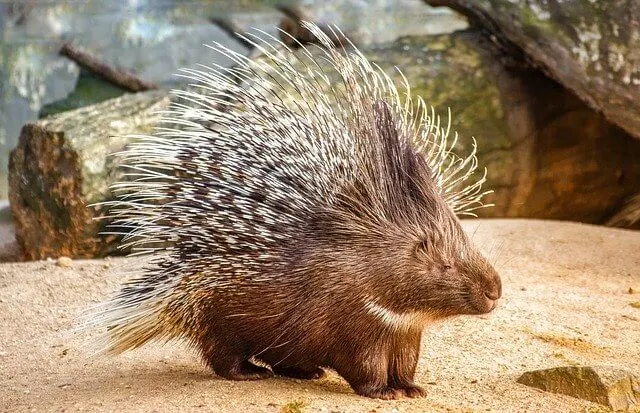
Scientific Name: Hystrix cristata
Lifespan: 20 years
Conservation Status: Least Concern.
Countries where they can be found: African Crested Porcupine can be found in Northern African countries of Algeria, Morocco and Tunisia as well as a number of western and central African countries including Senegal, Ghana, Guinea, Nigeria, Uganda, Ethiopia and Tanzania.
Collective Noun: Prickle of Porcupines
Quick Facts about Porcupine:
- The African Crested Porcupine is said to be one of the largest rodents in the world. It can grow to up to 3 feet in length and often weighs up to 30kg.
- The African Crested Porcupine is also widespread throughout Italy- the only European country where it exists.
- The name Porcupine is said to come from the French ‘porc espin’, meaning spined pig.
.
Aardwolf
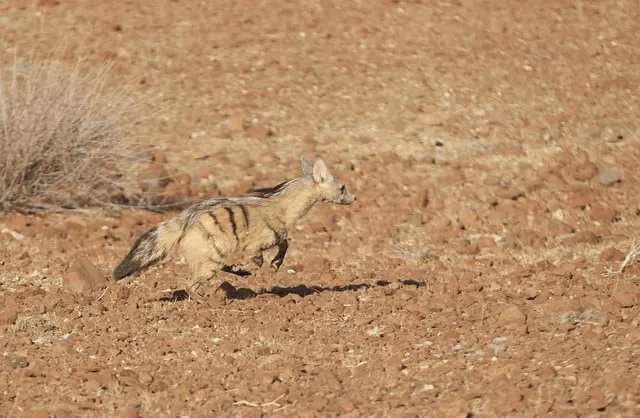
Scientific Name: Proteles cristata
Lifespan: 8 years in the wild up to 15 in captivity
Conservation Status: Least Concern
Countries where they can be found: South Africa, Angola, Zambia and Mozambique plus Egypt, Ethiopia, Somalia, Sudan, Tanzania and Uganda
Quick Facts about Aardwolf:
- The name ‘aardwolf’ means ‘earth wolf‘ in Afrikaans
- The aardwolf is a member of Hyaenidae, the hyena family. However, unlike other members of this family, the aardwolf doesn’t hunt or scavenge large animals.
- It is a specialized insectivore (insect eater) that mainly eats termites and can eat over a quarter of a million termites in one night(!)
- The aardwolf is shy and reclusive (and why it’s on the Shy 5 list!) It sleeps in underground burrows during the day and emerges at night to forage.
- Aardwolves have specialized cheek teeth. They have strong jaws and canine teeth, but their cheek teeth have been reduced to flattened pegs, used for eating insects.
- Aardwolves are territorial. A mating pair of aardwolves has a home range of up to four square km; and both sexes mark their territories with secretions from their anal glands.
.
Bat-eared fox
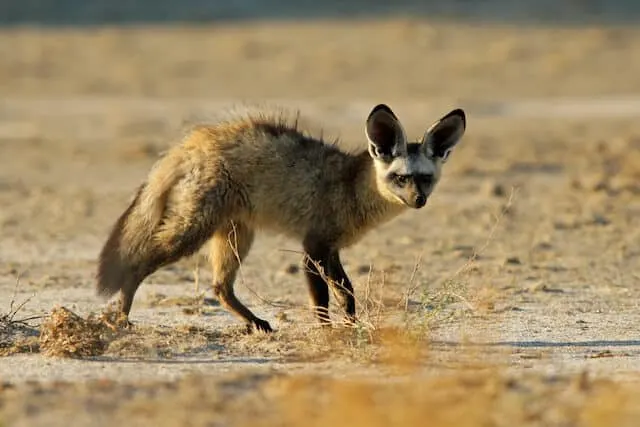
Scientific Name: Otocyon megalotis
Lifespan: Up to 6 years in the wild. 6 to 14 years in captivity
Conservation Status: Least Concern
Countries where they can be found: Native to more than 10 African countries including Kenya, Zimbabwe, Botswana, Namibia and South Africa.
Quick Facts about the Bat-Eared Fox:
- In Botswana, indigenous people hunt the bat-eared fox for their pelts and in South Africa, they are hunting trophies. They are also often perceived as threats and predators of small livestock. And in the animal world, they are hunted by many large predators but are hard to catch; hyenas and jackals are much more of a threat, as are eagles swooping.
- Their ears are a huge 13cm tall and make up a third of a bat-eared fox’s height – as such they have incredible hearing, and can even hear insects moving underground.
- Their ears are also filled with tiny blood vessels and help keep them cool.
- Bat-eared foxes are nocturnal. They spend most of the day resting in burrows, before emerging after dark to forage and hunt.
- Bat-eared foxes can take most of the water they need from the food they eat. Essentially they drink the bodily fluids of beetles and termites they feed on.
- Bat-eared foxes flip traditional gender roles. Females give birth to 3-6 cubs each year but the males will groom, play, babysit, and rear their young as well as guarding the den against predators, whilst the females forage for food.
The Impossible 5 African Animals
The Impossible 5 of Africa are the Aardvark, Cape Mountain Leopard, Pangolin, Riverine Rabbit and White Lion – and are named because they a practically impossible to spot in the wild!
Aardvark
This lucky critter gets a mention in one of the other ‘5’ African animals lists. Scroll back up to the Shy 5 to read all about them.
Cape mountain leopard
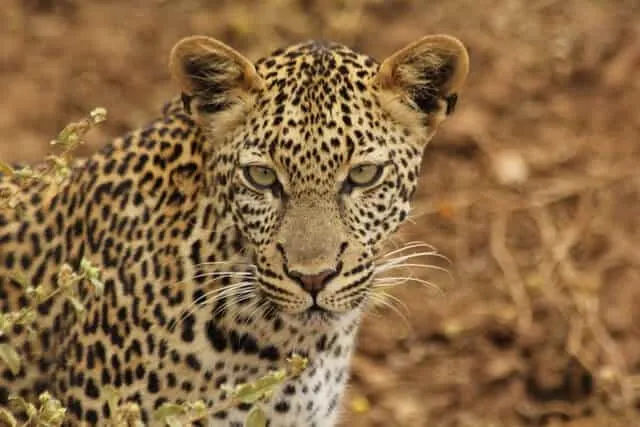
Scientific Name: Otocyon megalotis
Lifespan: Up to 6 years in the wild. 6 to 14 years in captivity
Conservation Status: Least Concern
Countries where they can be found: Native to more than 10 African countries including Kenya, Zimbabwe, Botswana, Namibia and South Africa.
Quick Facts about the Cape Mountain Leopard:
- The Cape Mountain Leopard is smaller than other leopard species in Africa, with males weighing in at a maximum of 35kg, and females around 20kg.
- They live in some of the most inhospitable environments on the continent in the low nutritional fynbos biome of the Cape Fold Mountain ranges, which contributes to their elusiveness.
- Cape Leopards have a home territory of 200 and 100km square, much larger than the savannah leopard at 25-50km²
- Females give birth to 2-3 cubs per litter, but hard conditions mean there is a high mortality rate in the first 6 months of life.
- Cape mountain leopards are opportunistic and adaptive hunters. They mainly target rock rabbits, klipspringers, Cape grysbok, and porcupines. Baboons and livestock do not form a major part of their diet.
Pangolin
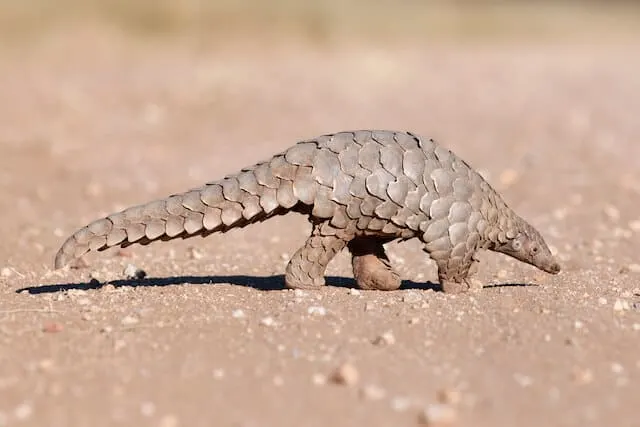
Scientific Name: Manidae
Lifespan: Unknown
Conservation Status: Vulnerable to Critically Endangered (dependant on sub-species)
Countries where they can be found: Throughout Central, East & South Africa (and Asia)
Collective Noun: (there isn’t a collective noun for pangolins due to their solitary nature)
Quick Facts about the Pangolin:
- Also known as the scaly anteater, when in danger the pangolin is able to roll into a ball, exposing only the tough scales for protection
- Despite the fact they look a lot like anteaters and armadillos, pangolins are actually more closely related to bears, cats, and dogs.
- They are the most trafficked non-human mammal in the world. Prized for their meat in Asia (and increasingly in Africa), their scales have also been (illegally) used in Chinese Medicine and traditional remedies for years.
- All eight pangolin species are protected under national and international laws but their illegal trade continues to boom.
Riverine rabbit
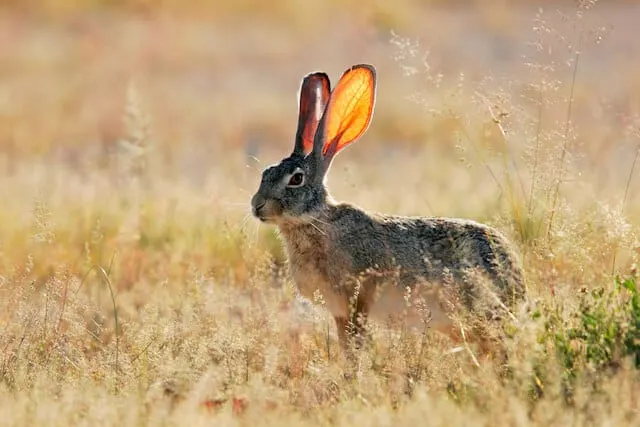
Scientific Name: Bunolagus monticularis
Lifespan: 4 years
Conservation Status: Critically endangered and facing high risk of extinction in the wild.
Countries where they can be found: Karoo Region of South Africa
Quick Facts about the Riverine Rabbit:
- It has a similar appearance to most rabbits, but the ears and body are longer.
- It typically has a black stripe running from the corner of the mouth over the cheek, and a white ring around each eye.
- These rabbits produce 2 kinds of droppings: Nighttime droppings are hard like pellets, while day time droppings are soft (and are often re-ingested).
- The females are called ‘doe or jill’ and males are know as a ‘buck or jack’.
White lion
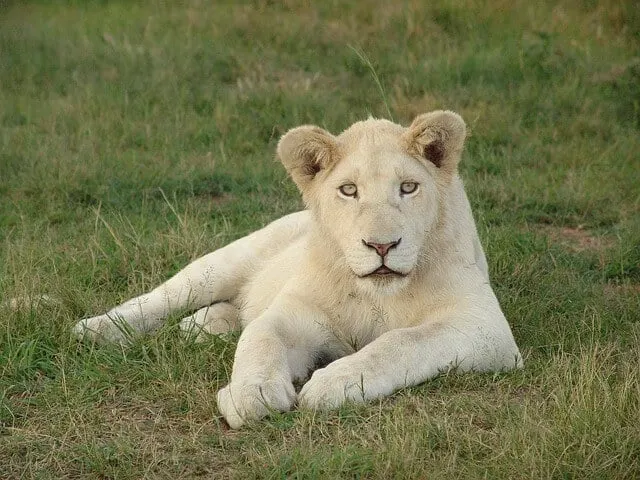
Scientific Name: Panthera Leo
Lifespan: Up to 18 years
Conservation Status: Critically Endangered
Countries where they can be found: Timbavati region of South Africa
Quick Facts about the White Lion:
- In 2020, we believe there are 13 white lions in the wild, the remaining 300 are in captivity.
- The white lion is not ‘albino’ but is so-colored as a result of a rare recessive trait that causes the white skin coloring.
- White lion cubs have been born in the Timbavati Private Nature Reserve in 2006, 2008, 2009, 2011, 2012 and 2013, and in the Nwanetsi Area of Kruger National Park in 2014 and 2015. This confirms that white lions are a natural occurrence and the recessive gene is still present in the wild population.
Other Amazing African Safari Animals That Don’t Make a ‘5’ List
Mountain Gorillas
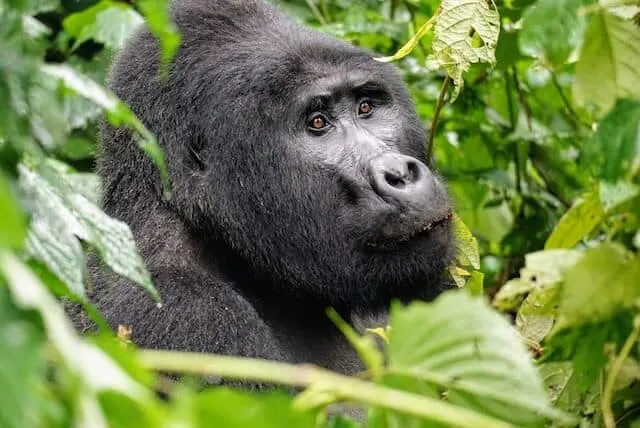
Silverback Gorilla in Bwindi Impenetrable National Park, Uganda
Scientific Name: Gorilla Beringei
Lifespan: 35-40 Years (in the wild)
Conservation Status: Engangered
Countries where they can be found: Rwanda, Uganda, Democratic Republic of the Congo (DRC)
Collective Noun: Troop, Band, Whoop of Gorillas
Quick Facts about:
- According to the last census results, there are just over 1,000 Gorillas left in the wild ( which makes them one of the most important animals in Uganda.)
- They live in the mountains at an altitude between 8,000 to 13,000 feet (and so why you have to join a Gorilla trekking hike to find them!)
- They can be found in Bwindi Impenetrable National Park (Uganda) and Virunga Volcanoes Range which covers 3 national parks in Uganda, Rwanda and the DRC.
- Mountain Gorillas share 98.3% of their DNA with humans. (Putting them our 3rd closest cousin after Chimpanzees and Bonobos.
- Much like humans, they live in family groups of around 10 individuals, and they even like to snuggle at night.
- Gorillas are one of the most powerful primates on the planet, with an average male mountain gorilla weighing in at 180kg and standing 170cm tall.
Hippo
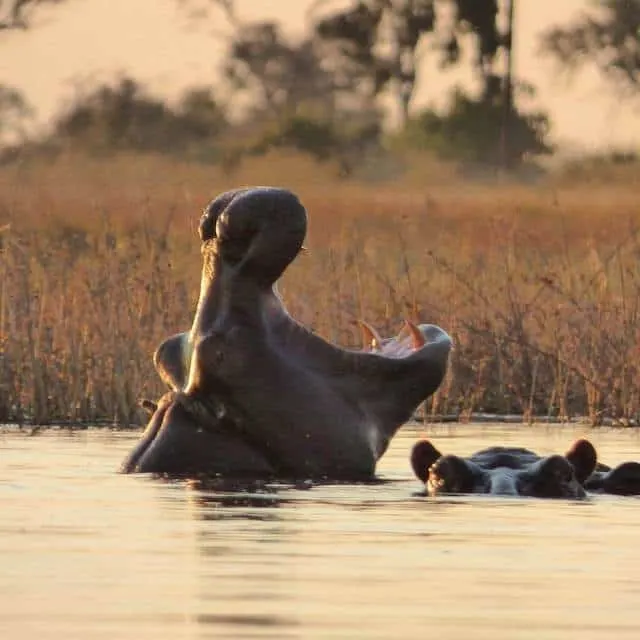
Hippos in the Okavango Delta Botswana
Scientific Name: Hippopotamus amphibius
Lifespan: Up to 40 years
Conservation Status: Vulnerable
Countries where they can be found: Eastern Central and Southern Sub-Saharan Africa
Collective Noun: Bloat of Hippos
Quick Facts about Hippos:
- They are the most deadly land mammal in the world killing 500 people per year. They are also one of the loudest. Their snorts, grumbles and wheezes have been measured at 115 decibels (that’s the same as being 4.6m from the speakers at a concert)
- They are the third-largest living land mammals, growing to 3.3-5m long 2m tall – which may not sound too scary, but add in the fact they can weigh (fully grown) anywhere between 2,000-4,000kg and they are certainly intimidating.
- Hippos have a healthy and mostly herbivorous appetite. Adults eat about 35 kg of grass per day/night and can travel up to 10km a night to find it.
- Hippos can run up to 30km/h (over short distances)
- Hippos can’t swim, but rather they walk along the bottom of rivers and waterways. They have to resurface to breath every 3-5 minutes – but this process is so natural, they even do so in their sleep, without needing to wake up!
- Hippo calves weigh between 23-50kg at birth (ouch!)
Giraffe
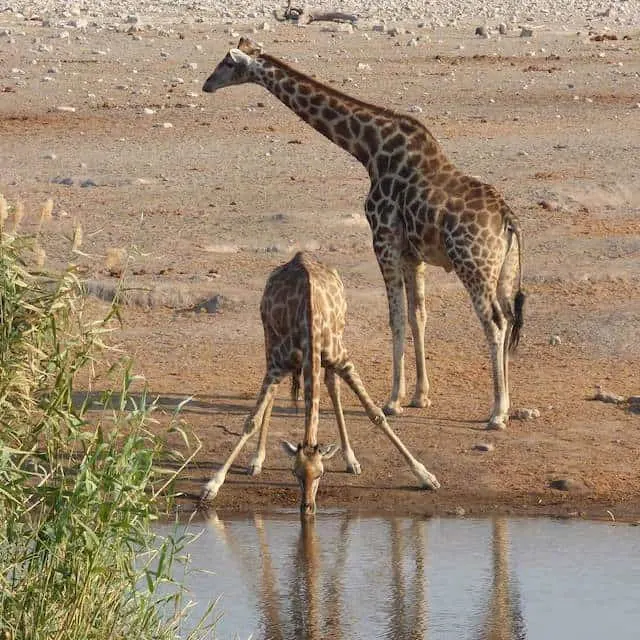
Scientific Name: Giraffa
Lifespan: Up to 26 years in the wild
Conservation Status: Least Concern
Countries where they can be found: Throughout sub-Saharan Africa including Kenya, Cameroon, Chad, Niger, Uganda, Namibia, Botswana, Zimbabwe, Zambia, Tanzania, Angola, and South Africa.
Collective Noun: Journey, Herd or Tower of Giraffes
Quick Facts about Giraffes:
- There are four distinct species of giraffe: Northern giraffe (Giraffa camelopardalis), Southern giraffe (giraffa), Reticulated giraffe (G. reticulata) and Masai giraffe (G. tippelskirchi).
- The endangered Rothschild Giraffe is a sub-species of the Northern Giraffe and has become synonymous with one of the most insta-famous hotels in Africa – Giraffe Manor.
- The giraffe is the tallest mammal in the world, standing at around 4-5m high and can weigh up to 1900kg.
- Their tongues are bluish-purple and between 45 and 50 cm long; and their heart can weigh up to 11kg.
- They can run as fast as 35 miles per hour over short distances.
- Just like human fingerprints, no two giraffes have the same coat pattern
- A giraffe’s neck is too short to reach the ground. In order to drink it has to awkwardly spread its front legs (as above) or kneel to reach the ground.
- Giraffes only need to drink once every few days, with most of their water coming from all the plants they eat.
Zebra
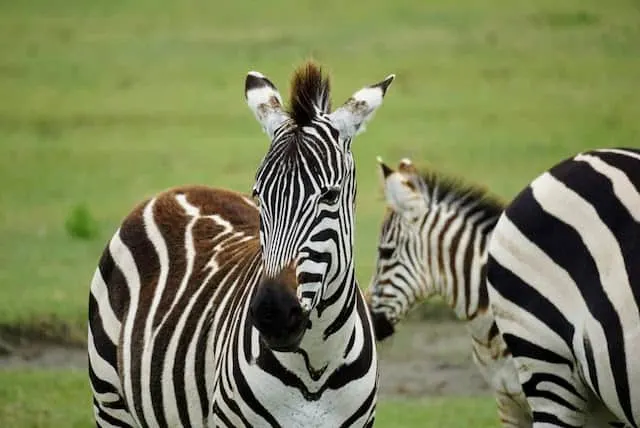
Scientific Name: Equus (With 3 extant species: the Grévy’s zebra (Equus grevyi), plains zebra (E. quagga) and the mountain zebra (E. zebra)
Lifespan: Up to 25 years in the wild
Conservation Status: The plains zebra is not endangered, the mountain zebra is considered vulnerable and the Grevy’s zebra is endangered
Countries where they can be found: Widespread across vast areas of southern and eastern Africa (making them very easy to spot) – but are extinct in Lesotho and Burundi.
Collective Noun: Dazzle, Zeal of Zebra
Quick Facts about Zebras:
- A favorite animal on game drives, the pattern of a zebras stripes are unique to each individual zebra – with no 2 zebras ever having the same markings.
- Zebras run in a zig-zag pattern when being chased by a predator to make it more difficult for the predator to run after them.
- When faced by predators, zebras will form a semi-circle and bit, nip or attack the predators if they come to close to them. They will also encircle an injured family member to protect it from further attack if the need arises.
- Zebras can reach speeds of up to 65km per hour – which is just fast enough to outpace predators such as lions.
- Zebras are black with white stripes.
- A zebra’s stripy coat is thought to disperse more than 70 percent of incoming heat, preventing the animal from overheating in the African sun. The stripes also help camouflage the animals, as their coat resembles grass when they stand together.
- Zebras can rotate their ears in almost any direction; this ability is used to communicate their mood with other zebras.
African Wild Dogs
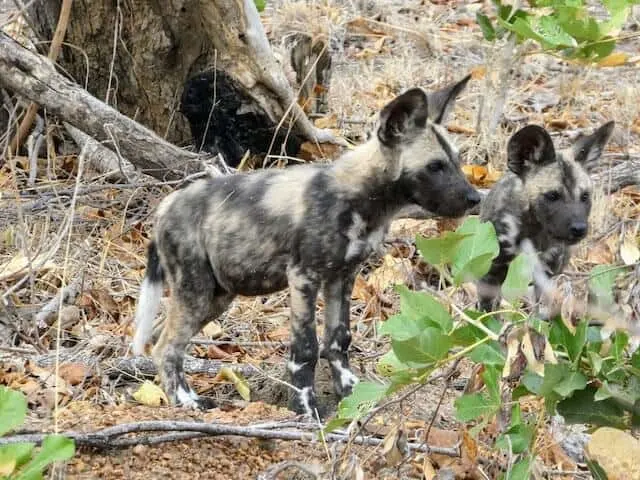
Scientific Name: Lycaon pictus
Lifespan: Up to 11 years in the wild
Conservation Status: Endangered
Countries where they can be found: Botswana, Zimbabwe, Namibia, Zambia, Tanzania, and Mozambique.
Collective Noun: Pack
Best Game Parks to see African Wild Dogs:
Selous Game Reserve (Tanzania); Moremi Game Reserve (Botswana); South Luangwa National Park (Zambia); Kruger National Park (South Africa); Madikwe Game Reserve (South Africa); Ruaha National Park (Tanzania); Hwange National Park (Zimbabwe) & Mana Pools National Park (Zimbabwe)
Quick Facts about African Wild Dogs:
- The African Wild Dog is known by many names, including Cape hunting dog or painted dog. Its scientific name, Lycaon pictus, means “painted wolf.”
- African Wild Dogs live in packs, typically headed by a monogamous breeding pair – the female of which has a litter of 2-20 pups which the whole pack then raise together
- They are one of the most endangered mammals in the world due to loss of habitat with human encroachment, conflict with humans (they are killed by farmers who feel their crops are threatened, get caught in traps, hit by cars, etc), and infectious diseases.
- Unlike domestic dogs, wild dogs only have four toes per forefoot.
- Wild dogs also have large, round ears that allow them to hear audio signals of pack members over long distances.
Nile Crocodile
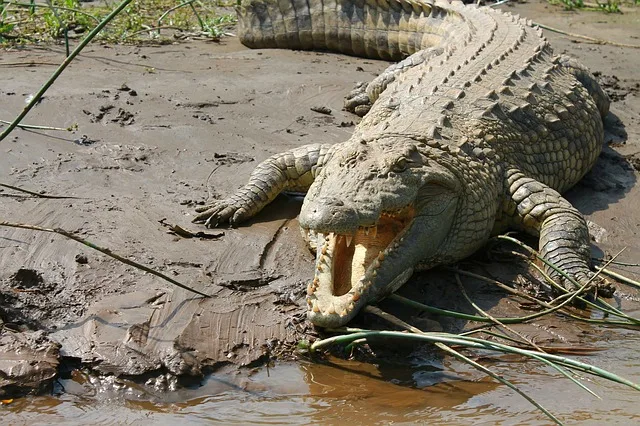
Scientific Name: Crocodylus niloticus
Lifespan: 70-100 years
Conservation Status: Least Concern
Countries where they can be found: Widespread through 26 African Countries throughout West Africa, East Africa, Central Africa and Southern Africa
Collective Noun: Congregation, Float of Crocodiles (in the water); Bask of Crocodiles (on land)
Quick Facts about Crocodiles:
- There are actually 5 species of crocodiles in Africa, but the Nile Crocodile is the most prolific with an estimated 50,000-70,000 mature individuals in the wild, distributed across 26 countries.
- The Nile Crocodile is the largest reptile in Africa and the second largest crocodile in the world (the largest being the Saltwater Crocodile found in Australia, India and SE Asia.)
- The Nile crocodile is typically around 3-4.5m in length, (but can reach over 6m) and weigh over 1,000kg.
- The Nile Crocodile is an apex predator with no natural predators of its own and will eat virtually anything that crosses it’s path.
- A female crocodile will lay between 25-80 eggs in a nest on the bank, who hatch within 90 days. The mother will stay near the nest to guard the eggs, and will look after the babies for around 2 years after the eggs have hatched.
Honey Badger
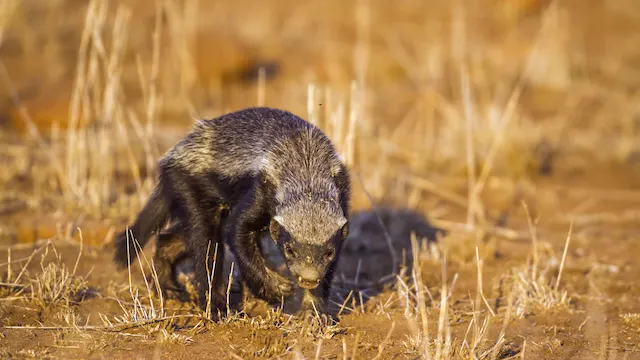
Scientific Name: Mellivora capensis
Lifespan: Approx 24-26 years in captivity, unknown in the wild.
Conservation Status: Least Concern
Countries where they can be found: Most of sub-Saharan Africa (as well as Arabia and Asia)
Quick Facts about:
- Despite their cute-sounding name, Honey Badgers are actually one of the most ferocious animals in Africa and have been known to attack humans, lions and buffalo when threatened.
- Honey Badgers feed on a wide variety of foods including lizards, rodents, turtles, frogs, insects, eggs, fruit, reptiles, larvae, grubs and berries – but their favourite food is honey (hence their name).
- They are nocturnal creatures, and as such are particularly hard to spot in the wild.
- The honey badger has a gland that stores stinky liquid at the base of the tail, much like a skunk – but the smell does not last as long as a skunks does.
Bush Baby (Galago)
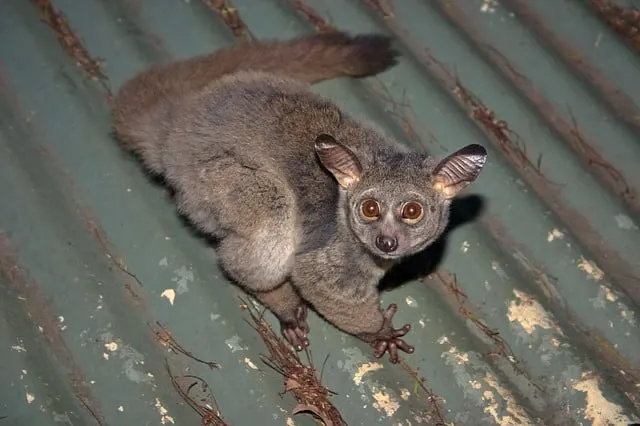
Scientific Name: Galagidae
Lifespan: Up to 14-16 years
Conservation Status: Least Concern (population stable)
Countries where they can be found:
Quick Facts about:
- Bush Babies are a very rare sight on a wildlife safari – you’re more likely to see these guys at night if your hotel balcony backs onto trees!
- Bush Babies are also known as nagapies, which means “night monkeys” in Afrikaans, due to their nocturnal nature.
- There are several types of bush baby, the most prominent are the thick-tailed bush babies and the lesser bush babies. The thick tailed bush baby is more than twice as large and 8 times as heavy as the lesser bush baby.
- They have big saucer-like eyes, bushy tails and large ears which they use to track each other and prey. Their hearing is so good that they can catch flying insects.
- They mark their territory with a process called urine washing which involves dribbling urine over their hands and feet and then rubbing them together. Once done, wherever they walk, they leave a trail.
Chimpanzee
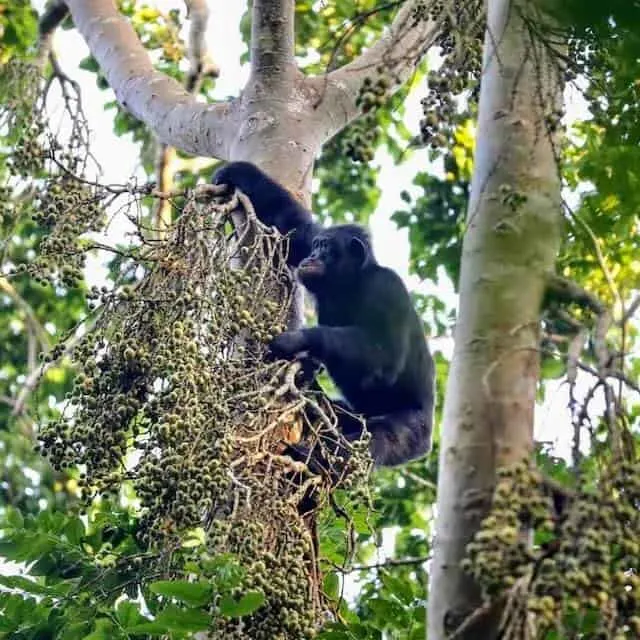
Chimpanzee in Kalinzu Central Forest Reserve, Uganda
Scientific Name: Pan troglodytes
Lifespan: Up to 50 years in the wild, Up to 60 years in captivity
Conservation Status: Endangered (approx 172,000 and 300,000 chimpanzees remain in the wild).
Countries where they can be found: Southern Senegal, Democratic Republic of the Congo, Western Uganda, Rwanda and Western Tanzania
Collective Noun: A Troop, Whoop, Family or Cartload of Chimpanzees
Best Places to Trek to see Chimpanzees in the Wild:
Uganda: Kalinzu Central Forest Reserve – Kibale National Park, Kanyanchu – Kyambura Gorge, Queen Elizabeth National Park
Rwanda: Nyungwe National Park, Cyamudongo Forest
Tanzania: Mahale Mountains National Park – Gombe Stream National Park (where Jane Goodall conducted most of her research)
Quick Facts about Chimpanzees:
- Chimpanzees are one of the 4 species of ‘great apes’ which includes Gorillas, Bonobos, Chimpanzees, and Orangutans
- Humans and chimpanzees share 95 to 98 percent of the same DNA. Biologically, chimpanzees are more closely related to humans than they are to gorillas.
- Chimpanzees – like Gorillas – are susceptible to human diseases.
- Chimpanzees eat seeds, fruit, leaves, bark, honey, flowers, insects and also hunt other monkeys or small antelope, for meat.
- Chimpanzees laugh when they play.
- Chimpanzees communicate much like humans do by kissing, embracing, touching hands, tickling, patting on the back, etc.
- Chimpanzees cannot speak, they communicate by using hand gestures, body posture, facial expressions and they make various noises and calls such as grunts, barks, pant-hoot, screeches and whimpers.
Jackal
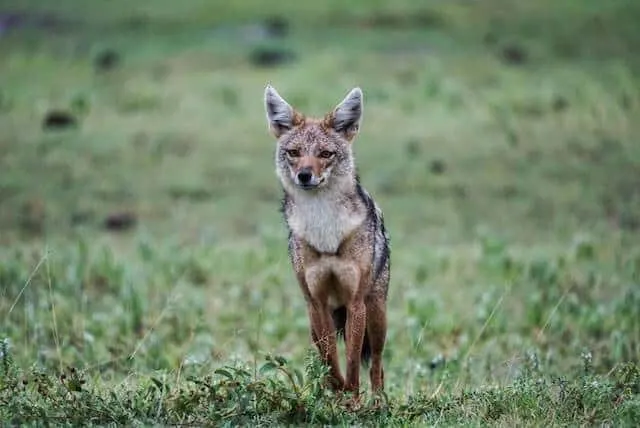
Scientific Name: Common jackal (Canis aureus), Side-striped jackal (Canis adustus), Black-backed jackal (Canis mesomelas)
Lifespan: 8-9 years in the wild, up to 16 years in captivity
Conservation Status: Least Concern
Countries where they can be found: Wildly distributed across North and East Africa
Quick Facts about Jackals:
- There are 3 species of Jackals: Common Jackals are a sandy-colored and prefer open, grassy plains. Side stripe jackals is drabber in colour with a white tip on the tail and lives in along waterways with dense undergrowth. The black-backed jackal is the most frequently seen – it has black hair across it’s back with a rust-colored body and lives in savannahs and woodlands.
- Jackals are often seen in pairs, are monogamous and have one partner for life.
- They hunt small antelopes and also eat reptiles, insects, ground-dwelling birds, fruits, berries, and grass. They will pick over kills made by larger carnivores and even frequent trash cans and rubbish dumps in pursuit of food (another reason NOT to have food in your tent when camping in a national park!)
- Jackals are related to dogs, coyotes, foxes and wolves.
Cheetah
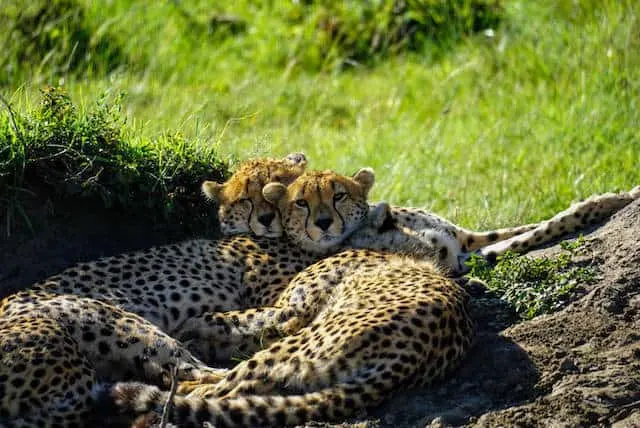
Scientific Name: Acinonyx jubatus
Lifespan:
Conservation Status: Vulnerable (population decreasing, approximately 10,000-12,000 in the wild)
Countries where they can be found:
Collective Noun: Coalition of Cheetahs
Best Game Parks to see Cheetahs in the Wild:
Masai Mara, Kenya; Kruger National Park, South Africa; Private Reserves in Kwa-Zulu Natal, South Africa; Serengeti National Park, Tanzania; Etosha National Park, Namibia; Central Kalahari, Makgadikgadi & Nxai Pan in Botswana.
5+ Interesting Facts about Cheetahs:
- The cheetah is the fastest land animal in the world, reaching speeds of up to 113km/h (70mph) and they can accelerate from 0 to 100km/h in just 3 seconds.
- Traveling at such speeds is exhausting and can only be maintained for 200-300m.
- Cheetahs have between 2,000 and 3,000 spots, which help them to camouflage themselves.
- Female cheetahs are solitary, living alone or with their young. Males live in small family groups of 2–3 brothers although in 2020 there is currently a family of 5 Cheetah Brothers who currently live in Kenya’s Maasai Mara National Reserve (and were featured by David Attenborough in Seven Worlds, One Planet)
- Cheetahs have long, flat, muscular tails that they use for balance and steering. The tail essentially acts like a rudder on a boat.
- Cheetahs can survive only drinking water every 3-4 days.
- Cheetahs hunt during the day to avoid competition from other powerful predators such as lions, hyenas and leopards.
Antelope
There are over 90(!) different species of antelope in Africa which include Eland, Nyala, Waterbuck, Klipspringer, Gerenuk, Roan Antelope, Topi, Hartebeest, Thomsons Gazelle, Sable Antelope, Impala, Springbok (and obviously quite a few more!) But the ones below are, in my opinion, the most impressive/beautiful/interesting.
Kudu
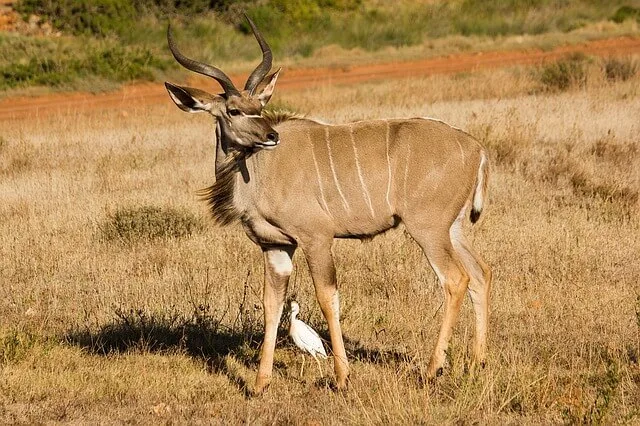
Scientific Name: Tragelaphus strepsiceros
Lifespan: 10 years in the wild, 23 in captivity
Conservation Status: Least Concern (Population Stable)
Countries where they can be found: Ethiopia, Tanzania, Eritrea, Kenya, Zambia, Angola, Namibia, Botswana, Zimbabwe and South Africa.
Quick Facts about Kudu:
- There are 2 species of Kudu – the Greater Kudu and it’s cousin, the Lesser Kudu
- The greater kudu’s horns are spectacular and for an adult male (bulls) can grow as long as 1.8 meters, making 2.5 twists.
- The horns do not begin to grow until the bull reaches 6–12 months, twisting once at around two-years-of-age and not reaching the full two-and-a-half twists until the age of six.
- Bulls may stand 1.5 meters at the shoulder and weigh over 250kg.
- Kudus are rarely aggressive, but use their horns to spar with other males during mating season to show superiority.
Eland
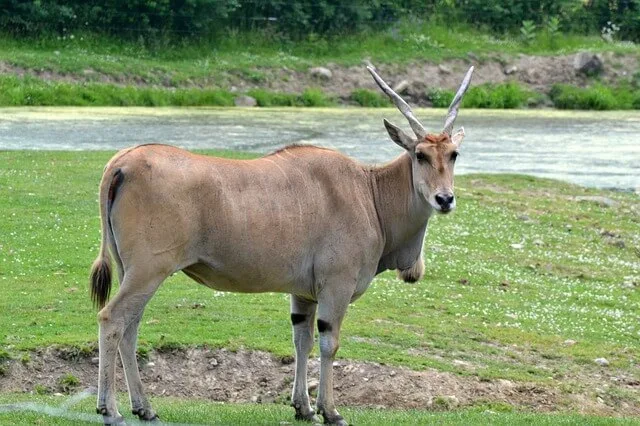
Scientific Name: Taurotragus derbianus
Lifespan: 20 years in the wild, 25 in captivity.
Conservation Status: Least Concern (Population stable)
Countries where they can be found: South Sudan, Ethiopia, Angola, Namibia, Botswana, Malawi, Tanzania, Swaziland, Zimbabwe and South Africa.
Quick Facts about Eland:
- The Giant Eland is the largest antelope in the world and the slowest antelope but can jump a 2.5m fence from a standstill if threatened.
- Elands are herbivorous with the majority of their diet made up of high protein succulent leaves from flowering plants, supplemented with forbs, trees, shrubs, grasses, tubers and seeds.
- Elands roam in herds of around 40-60 but can gather in herds of up to 500-1000 animals in the rainy season.
- Both male and female herds will often associate with zebras, roan antelopes and oryxes.
Impala
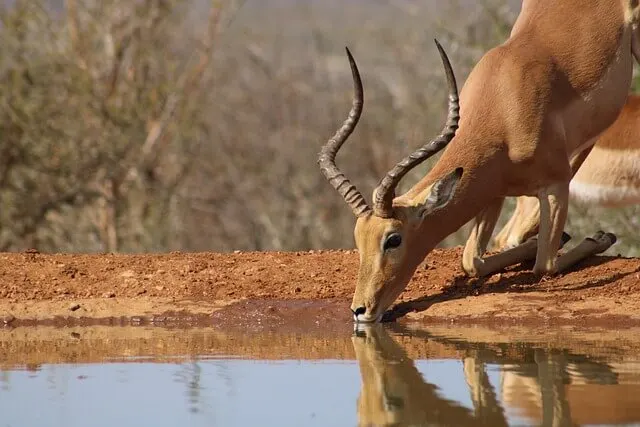
Scientific Name: Aepyceros melampus
Lifespan: 12 – 13 years in the Wild
Conservation Status: Least Concern (Population Stable)
Countries where they can be found: Angola, Namibia, South Africa, Botswana, Zimbabwe, Mozambique, Zambia, Tanzania and Kenya.
Quick Facts about Impala:
- There are two subspecies of impalas: the common impala (Aepyceros melampus melampus), and the black-faced impala (Aepyceros melampus petersi) – however the Black Face impala is particularly rare and only found in Namibia and Angola.
- The Common Impala is most common of all antelope in Africa and their population is estimated to exceed 2 million (in 2020)
- Males are known as rams with horns that can grow to 46 to 94 cm long, while females are referred to as ewes and have no horns.
- Impalas can run at up to 60km/h and are quite ‘springy’ being able to leap as far as 10 meters and as high as 3 meters.
- Most young impala are born around mid-day as this is the safest time to give birth (most of an Impalas natural predators – lions, leopards, cheetahs – are resting at this time). Mothers will leave the herd to give birth, returning to the herd 2-4 days later, however, half of newborns are killed by predators within the first few weeks of life.
- The impala is rarely seen on its own. Females and young animals form herds of up to 100 individuals, while males live in a bachelor group of about 60 animals.
Oryx / Gemsbok
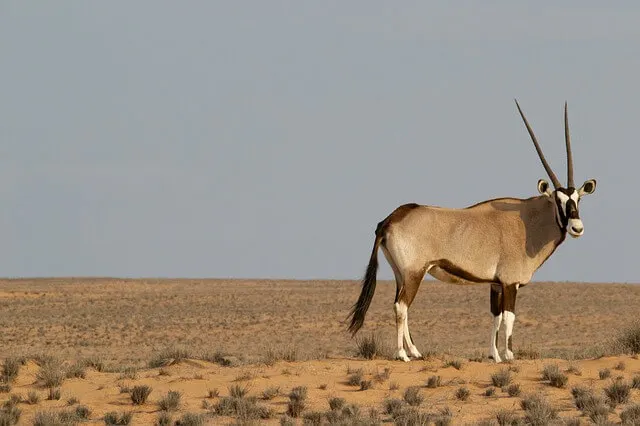
Scientific Name: Oryx gazella
Lifespan: Up to 18-20 years in the wild, 22 in captivity
Conservation Status: Least Concern (Population stable)
Countries where they can be found: Botswana, Namibia & South Africa
Quick Facts about Oryx:
- The East African oryx (aka Gemsbok) is a species of antelope with long, spear-like horns. They have a grey coat and a white underside, separated from the grey by a stripe of black.
- Oryx live in herds of up to 600 animals.
- A female Oryx leaves the herd to give birth and hides the calf for its first two or three weeks of life, visiting a few times a day to nurse it.
- Oryx eat coarse grasses and thorny shrubs. In desert areas, they consume thick-leaved plants, wild melons, and roots and tubers they dig out of the ground. They typically feed in the early morning and late afternoon.
Rock Hyrax
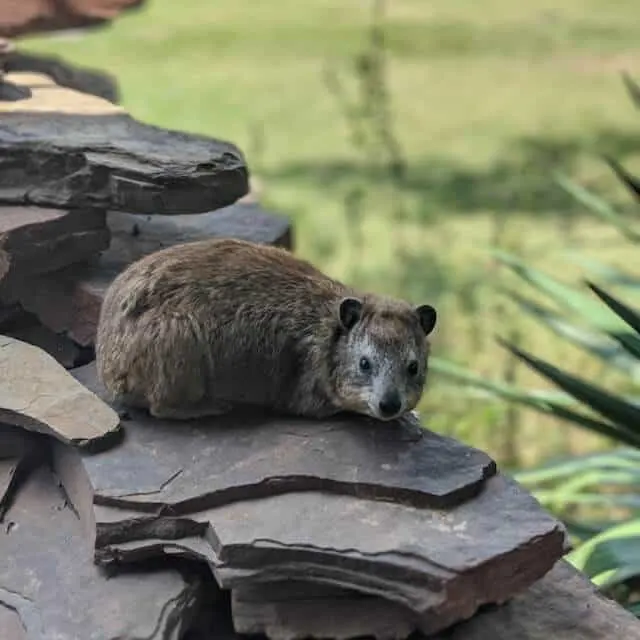
Scientific Name: Procavia capensis
Lifespan: 9 – 12 years
Conservation Status: Least Concern
Countries where they can be found: Widespread throughout Africa
Quick Facts about Hyrax:
- Rock hyraxes are gregarious, living in colonies of up to 80 individuals.
- They have three-chambered stomachs filled with symbiotic bacteria that help break down the plants they eat. Baby hyraxes are not born with the bacteria they will need to digest plant matter, so to obtain it they eat the poop of adult hyraxes.
- Hyrax are actually related to elephants and manatees.
- Hyraxes have black rubbery pads on their feet which are moistened by sweat glands and lift up in the center for a suction cup-like effect that helps the Hyrax keep their grip on rocky surfaces.
Stunning African Birds to Spot on Safari
Jackass Penguin
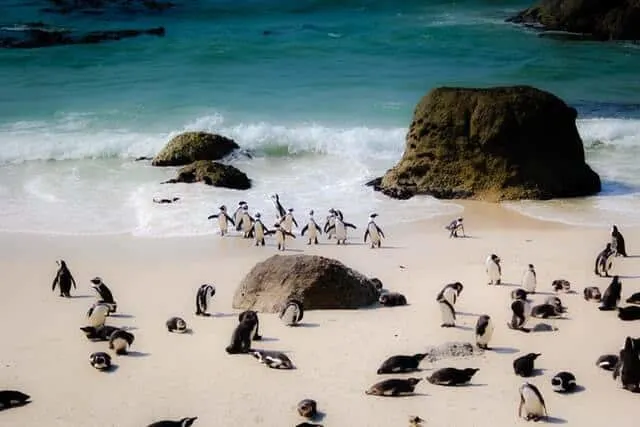
Scientific Name: Spheniscus demersus
Lifespan: 10 – 27 years in the wild, 30 in captivity.
Conservation Status: Endangered (Population Decreasing)
Countries where they can be found: South Western Coast of Africa along the Namibian and South African Coasts.
Quick Facts about the Jackass Penguin:
- The Jackass Penguin is also known as the African Penguin, or Cape Penguin.
- They make donkey-like braying sounds to communicate.
- They can dive under water for up to 2.5 minutes while trying to catch small fish such as anchovies and sardines.
- One of the most famous and accessible colonies are found at Boulders Beach and Simonstown, just outside Cape Town.
Ostrich
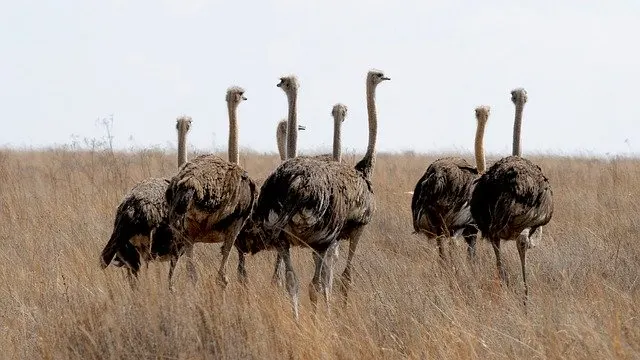
Scientific Name: Struthio camelus
Lifespan: 50 to 75 years
Conservation Status: Least Concern (Population decreasing)
Countries where they can be found: Widespread throughout Africa.
Quick Facts about Ostriches:
- The Ostrich is the largest, flightless bird in the world, growing up to 2m tall and weighing up to 170kg.
- Ostriches can run up to 70km/h and cover as many as 5m in a single stride.
- Ostriches have 3 stomachs.
- Male Ostrich have predominantly black feathers with white plumage, female have brown feathers with white tips.
- Ostrich eggs are the largest of any living bird at 15cm long.
- Ostriches normally spend the winter months in pairs or alone and during breeding season they live in nomadic ‘herds’ of between 5 and 50 birds, led by a top hen.
Hornbill
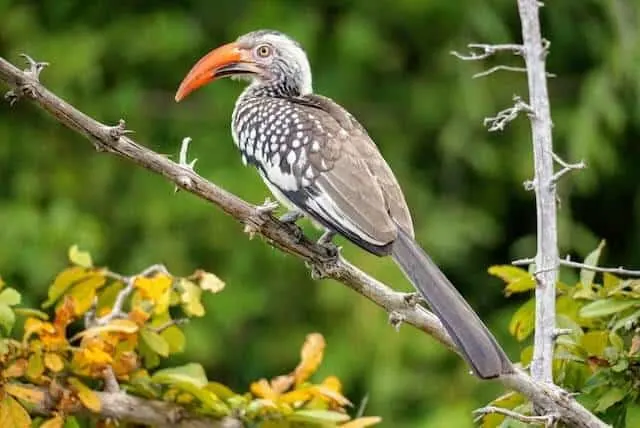
Scientific Name: Tockus erythrorhynchus
Conservation Status: Least Concern
Secretary Bird
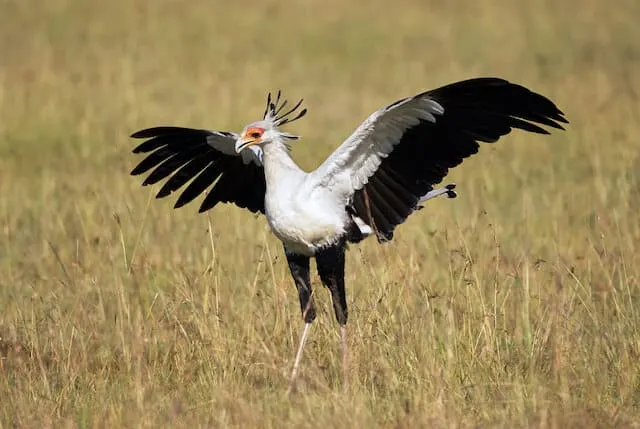
Scientific Name: Sagittarius serpentarius
Conservation Status: Vulnerable
Quick Facts about the SecretaryBird:
- This impressive bird of prey can stand up to 1.2m tall
- They move around mostly on foot, only flying when necessary such as reaching their nest and as part of the courtship ritual.
- Secretary Birds are carnivorous and eat snakes, insects, small mammals, birds’ eggs, crabs and other reptiles.
- Secretarybirds hunt on the ground and use the thickened soles of their feet to stamp on their prey, stunning it and then swallowing it whole.
Kori Bustard
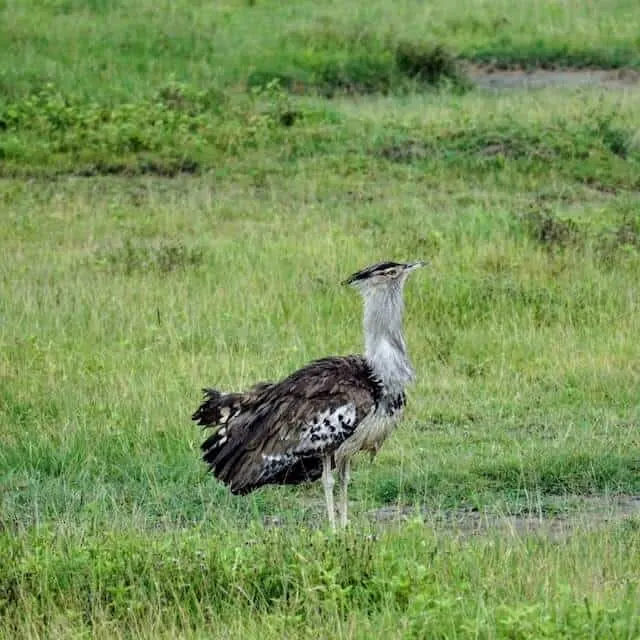
Scientific Name: Ardeotis kori
Conservation Status: Near Threatened (Population decreasing)
Quick Facts about the Kori Bustard:
- They are the heaviest flying bird native to Africa, however they mostly live on the ground, not flying unless absolutely necessary.
-
Kori bustards are distributed throughout eastern and southern Africa. They inhabit wide, open grasslands and lightly wooded savanna.
- Kori bustards are omnivorous birds, although they tend to be more carnivorous than other species of bustards. Insects form a large portion of their diet and they also eat a variety of small mammals, lizards, snakes, seeds and berries.
Grey Crown Crane
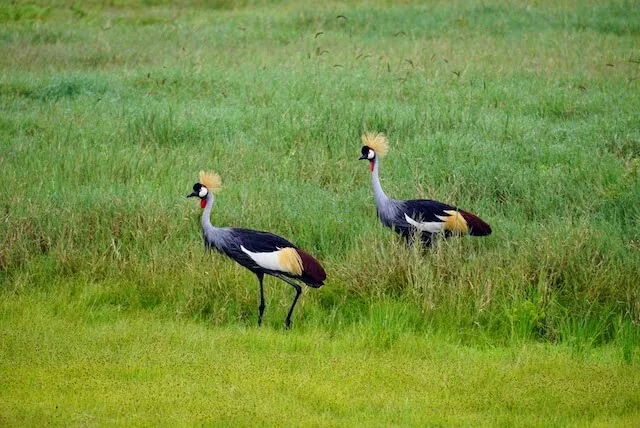
Scientific Name: Balearica regulorum
Conservation Status: Endangered (Population decreasing)
Southern Masked Weaver Birds

Scientific Name: Ploceus velatus
Conservation Status: Least Concern (Population stable)
Lilac-Breasted Roller
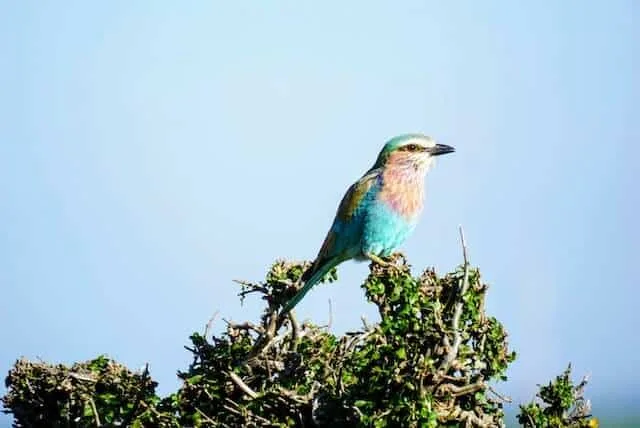
Scientific Name: Coracias caudatus
Conservation Status: Least Concern (Population stable)
Quick Facts about the Lilac Breasted Roller:
- They are the considered the national bird of Kenya.
- The bird is called ‘Kambu’ in Swahili.
- Lilac-breasted rollers feed off arthropods and small invertebrates and are fearless in their hunting technique – they swoop on large prey such slow-moving lizards, chameleons and snakes and discombobulate it with their wings until it is safe/small enough to eat.
Red Bishop
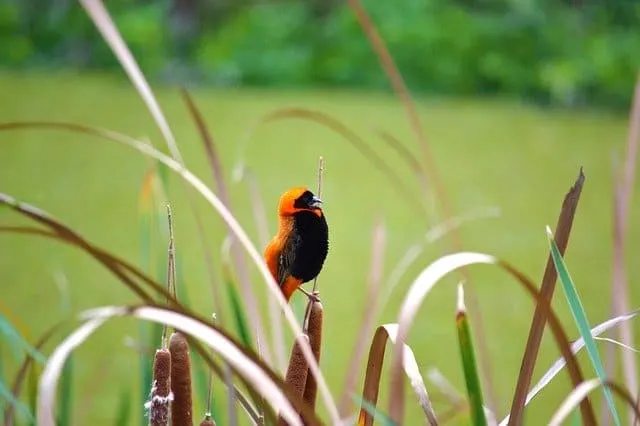
Scientific Name: Euplectes orix
Conservation Status: Least Concern (Population stable)
Saddle Billed Stork
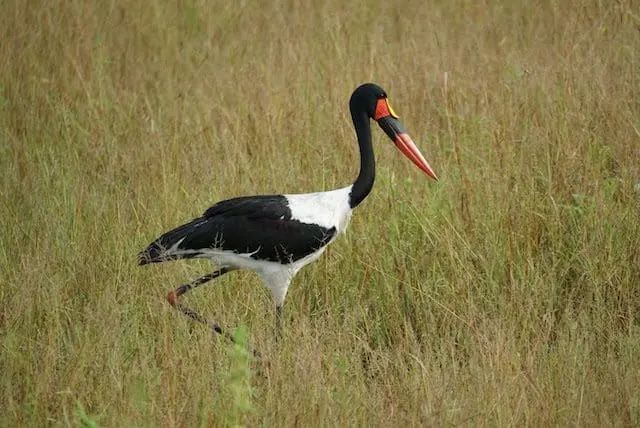
Scientific Name: Ephippiorhynchus senegalensis
Conservation Status: Least Concern (Population decreasing)
Helmeted Guinea-fowl

Scientific Name: Numida meleagris
Conservation Status: Least Concern (Population stable)
Flamingo (Lesser Flamingo)
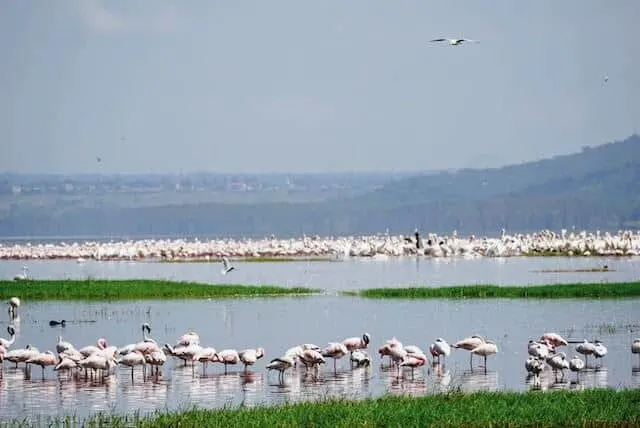
Scientific Name: Phoeniconaias minor
Conservation Status: Near Threatened (Population decreasing)
Malachite Kingfisher
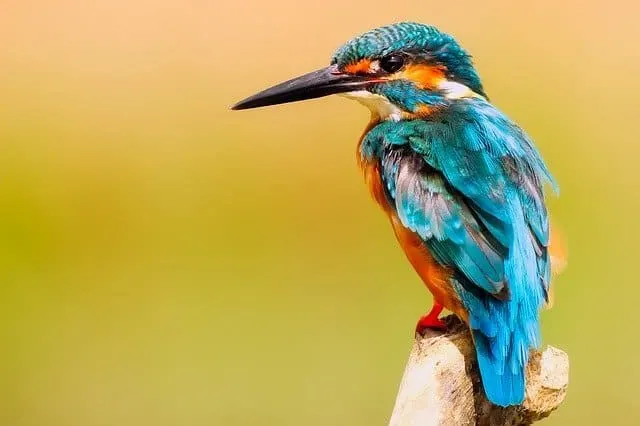
Scientific Name: Corythornis cristatus
Conservation Status: Least Concern (Population stable)
Cape Glossy Starling
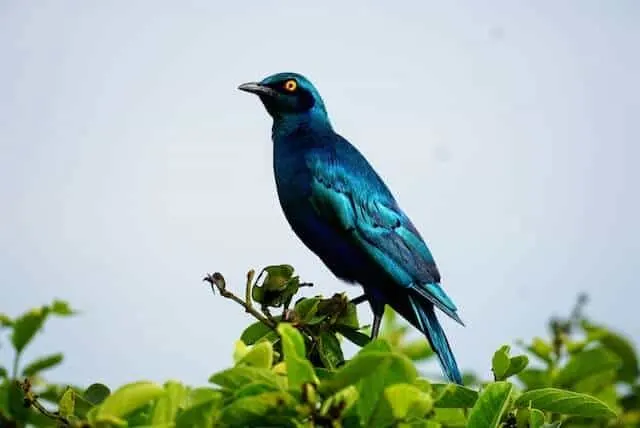
Scientific Name: Lamprotornis nitens
Conservation Status: Least Concern (Population stable)
And that’s a wrap! We hope you have enjoyed scrolling through these amazing safari animals and have added them to your list of safari animals to spot on safari in Africa. (And if you managed to see them all, it would be one incredible safari experience!).
If you’re struggling to find any of these animals in Africa despite being in any of the top safari destinations listed throughout this post, be sure to let your safari guide know exactly what you are looking for and I’m sure they will be able to help you out. When on safari in Africa – your safari guides will be your greatest asset, teachers and animal trackers!
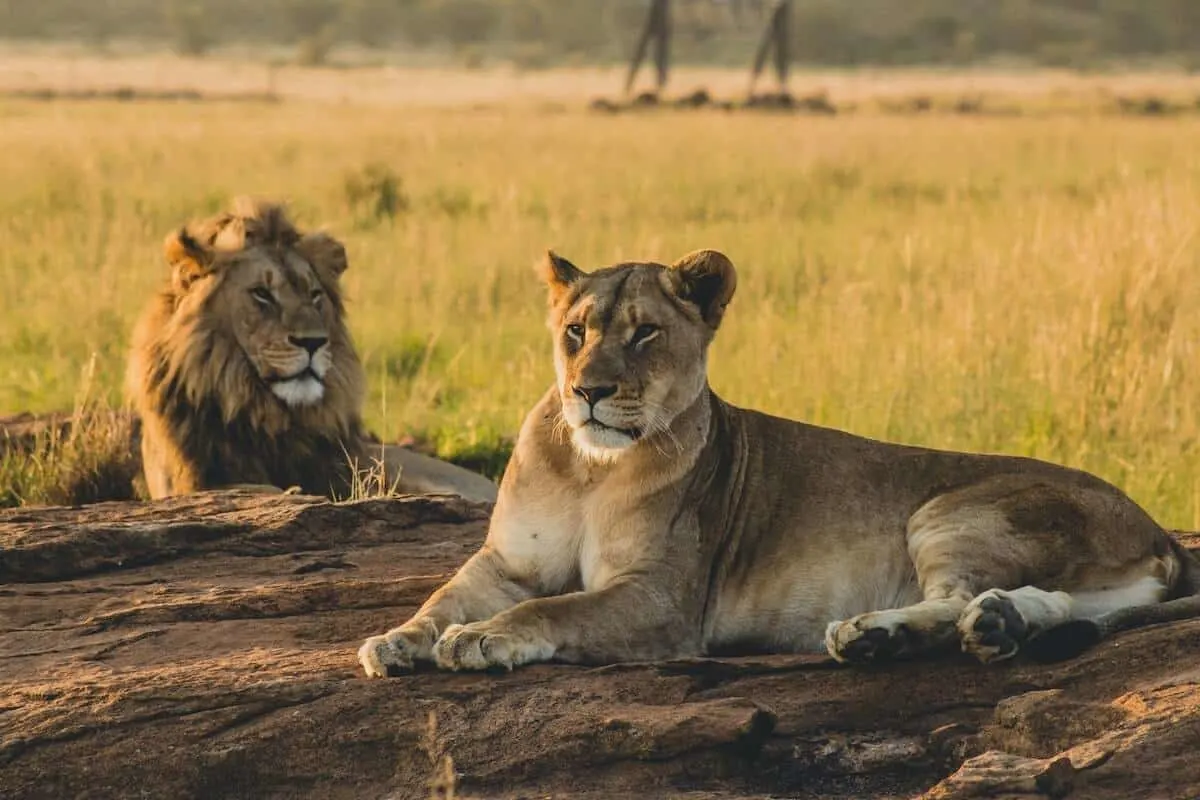 And if you liked this guide to the incredible African Safari Animals including the Big 5 Africa, Little 5 African Animals, Shy 5 African animals, Impossible 5 African Safari animals, Ugly 5 African Safari animals & so many more(!) take a look at the other Africa related content, recent posts, travel resources, travel guides, destination guides, ultimate guides and packing lists:
And if you liked this guide to the incredible African Safari Animals including the Big 5 Africa, Little 5 African Animals, Shy 5 African animals, Impossible 5 African Safari animals, Ugly 5 African Safari animals & so many more(!) take a look at the other Africa related content, recent posts, travel resources, travel guides, destination guides, ultimate guides and packing lists:
- Africa from North to South: The Ultimate South Africa Bucket List, Places to visit in Cape Town & The Best Time To Go To South Africa PLUS Best Places to Visit in Morocco, Things to do in Marrakech (+ Day Trip Ideas)
- The Ultimate Road Trip Packing List, Road Trip Tips, Road Trip Quotes & Road Trip Playlist – keeping you and your care happy, entertained & healthy on the road
- Get Eco Friendly on your sustainable travels: The Best Solid Toiletries (that you can take in your carry on) and Eco-Friendly Gifts for travel lovers.
- Travel Gear: Travel Backpacks & Carry On Luggage, passport wallets, camera backpacks & travel yoga mats!
- General Travel Inspiration! Travel Quotes, Adventure Quotes, Mountain Quotes, Beach Quotes, (to go with all those beach essentials!) Quotes about the Ocean & some of the most unique travel words with beautiful meanings!!
Hi There! Thanks for reading my travel tips and photo guide to African Safari Animals: Big 5, Little 5, Shy 5, Impossible 5 & Ugly 5! (And where to find these incredible African Animals) I just wanted to let you know that this post contains affiliate links, which means if you purchase something after clicking a link, I may get a small commission – which is at absolutely no cost to you. If you enjoyed this article and are going to be searching for some of the things I mention anyway, I would love it if you could click through from the links above & thank you in advance! Read my full Disclosure here.
And Thank you for reading the MakeTimeToSeeTheWorld travel blog posts.
